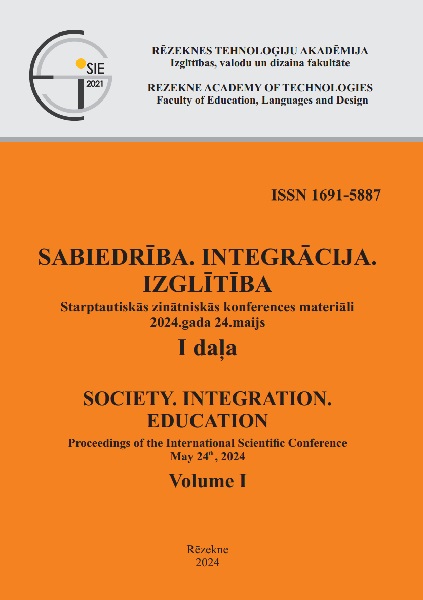PEDAGOGICAL THEATRE METHOD WITHIN THE MULTISENSORY APPROACH IN CAREER EDUCATION AT SCHOOL
DOI:
https://doi.org/10.17770/sie2024vol1.7886Keywords:
career education, multisensory approach, pedagogical theater method, sensesAbstract
Career is an important area of life, the development of which should be developed as early as school years. It is important to help a student get as much information as possible about opportunities in their career choices from the start of primary school, help them find the right direction for them, knowing their desires, skills and talents. Insufficient methodological support for primary school pupils in early stages of career education determines the problem of the study. The aim of the study is to theoretically investigate the Pedagogical Theater Method, to develop a Multisensory Approach Scheme Using the Theater Method to promote the development of students' sensory awareness in career education in the 5th Grade. A 24 pupil’s survey was conducted, descriptive statistics were used for data processing. Pedagogical theater method develops the skill of using the senses (sight, hearing, taste, smell or touch) and using real life experience, thus expanding opportunities for self-discovery and choosing a potential future career. The Multi-Sensory Approach, when several senses are stimulated at the same time, methodically using purposefully prepared tasks, promotes the development of students' sensory awareness, which can be used in career education and choosing a future profession. The Pedagogical Theater Method organically fits into the implementation scheme of the Multisensory Approach in Career Education for the 5th Grade. The Pedagogical Theater Method is suitable for the implementation of career education in work with pupils.
References
APA dictionary. (2023). Multisensory method. Retrieved from https://dictionary.apa.org/multisensory-method
Baines, L. (2008). A Teacher’s Guide to Multisensory learning Improving Literacy by Engaging the Senses. USA: The Association for Supervision and Curriculum Development (ASCD).
Baltušīte, R. (2000). Neirolingvistiskā programmēšana pedagoģijā. Rīga: Raka.
Banks, J. (2019). Sensory Labyrinth Theatre in relation to the individual, the audience member and performer, as part of a community. Journal of ContextOriented Arts, 1(1). Retrieved from https://journalofcoarts.pubpub.org/pub/ltf2sfnr/release/1
Bremner, J., Lewkowicz, J., & Spence, J. (2012). The multisensory approach to development. In J. Bremner, J. Lewkowicz, & J. Spence (Red.), Multisensory Development. Oxford: Oxford Academic. DOI: 10.1093/acprof:oso/9780199586059.003.0001
Cesie. (2021). Career Counselling in Italian secondary schools: the experience of the REFORM project. Retrieved from https://cesie.org/en/school/career-counselling-in-italian-secondary-schools-the-experience-of-the-reform-project/
Concrete Youth. (2023). An inclusive, groundbreaking, fully immersive world of sensory delights. Retrieved from https://www.concreteyouth.co.uk/what-is-multi-sensory-theatre
European Commission. (2022). Guidance and counselling in early childhood and school education. Retrieved from https://eurydice.eacea.ec.europa.eu/national-education-systems/italy/guidance-and-counselling-early-childhood-and-school-education
Exodus. (2021). Pedagogic Theatre as Non-Formal Education Method. Retrieved from https://www.exodusplatform.eu/pedagogic-theatre-as-non-formal-education-method/
Foxe, J. J., & Molholm, S. (2009). Ten years at the Multisensory Forum: Musings on the evolution of a field. Brain Topography. Retrieved from https://doi.org/10.1007/s10548-009-0102-9
VIAA. (2014). Karjeras kompass. Pieejams: https://viaagov.sharepoint.com/:w:/s/EGmateriali/EcgNlUA4mNxCtdLPmhvMOkQBPa3d7NFwWu2W6uGQKbvWXQ?e=cqsItb
Lacey, S., & Lawson, R. (2013). Multisensory Imagery. USA: Springer Science + Business Media. Retrieved from https://doi.org/10.1007/978-1-4614-5879-1
Meyer, G. F., & Noppeney, U. (2011). Multisensory integration: from fundamental principles to translational research. Retrieved from https://pubmed.ncbi.nlm.nih.gov/21800253/
Niles, S. G., & Harris-Bowlsbey, J. (2012). Career Development Interventions in the 21st Century (4 Ed.). UK: Pearson.
Pagliano, P. (2012). The Multisensory Handbook A guide for children and adults with sensory learning disabilities by Routledge. Routledge.
Praveen, A. (2021). What are Multisensory Teaching Techniques? Retrieved from https://www.lexiconreadingcenter.org/what-is-multisensory-teaching-techniques/
Preiļi izglītotai Latvijai. (2018). Drāmas un teātra metodes darbā ar jaunatni un pedagoģijā. Pieejams: http://www.preililatvijai.lv/2018/05/03/dramas-un-teatra-metodes-darba-ar-jaunatni-un-pedagogija/
Psychology Dictionary. (2013). Multisensory learning. Retrieved from https://psychologydictionary.org/multisensory-learning/
Pučuka, I. (2019). Multisensorā izglītība. Pieejams: https://epale.ec.europa.eu/lv/blog/multisensora-izglitiba
Rīgas Juglas vidusskola (RJV). (2021). RJV Skolotāju dalība starptautiskās apmācībās Itālijā “Beyond Visible”. Pieejams: https://rjv.lv/2021/12/12/rjv-skolotaju-daliba-starptautiskas-apmacibas-italija-beyond-visible/
Reece, L. (2018). Careers education in Primary Schools: Sowing Seeds of Confidence, Aspiration and Choice. Career Matters, 6(3). Retrieved from https://static1.squarespace.com/static/51ec1c81e4b0ca0d3590c5bd/t/5b52db426d2a73038b449671/1532156739298/CDI+Liz+Reece+article+on+primary+Careers+Education.pdf
Regan, R. (2023). Everything You Need to Know About Generation Z in The Workplace in 2023. Retrieved from https://connecteam.com/generation-z-in-the-workplace/
Rubene, Z. (2017, augusts 11). Digitālā bērnība. Sestdiena. Pieejams: http://www.izglitibasbiedriba.lv/2017/08/digitala-berniba-drpaed-zanda-rubene.html
Stahl, A. (2019). How Generation-Z Will Revolutionize the Workplace, Forbes. Retrieved from https://www.forbes.com/sites/ashleystahl/2019/09/10/how-generation-z-will-revolutionize-the-workplace/?sh=e6866014f537
Stein, B. E. (2012). The New Handbook of Multisensory Processing. Cambridge. MA.: MIT Press. DOI: https://doi.org/10.7551/mitpress/8466.001.0001
Šmite, J., Dišlere, V. (2023). Pētījums par multisensorās pieejas īstenošanu karjeras izglītībā 5.klašu skolēniem. LBTU IITF Studentu un maģistrantu zinātniskās konferences raksti, 176-183. Pieejams: https://www.iitf.lbtu.lv/sites/iitf/files/2023-09/TF%20magistrantu%20konference%202023.pdf#page=177
Teachment. (2023). Multisensory Teaching. Retrieved from https://www.teachmint.com/glossary/m/multisensory-teaching/
Tosey, P., & Mathison, J. (2006). Introducing Neuro-Linguistic Programming. Retrieved from https://web.archive.org/web/2190103020411/http://www.som.surrey.ac.uk/NLP/Resources/IntroducingNLP.pdf
Tūtere, J., Baltušīte, R. (2022). Multisensorā pieeja karjeras izglītībā pamatskolas 5. klasē, LBTU IITF Studentu un maģistrantu zinātniskās konferences raksti, 149-153. Pieejams: https://www.iitf.lbtu.lv/sites/iitf/files/2023-09/TF%20magistrantu%20konference%202022.pdf#page=149
VIAA. (2022). Profesiju pasaule. Pieejams: https://www.profesijupasaule.lv/esf-projekts






